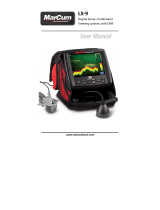
- 4 -
properly, the on-screen menu will shut off automatically.
Occasionally, you may find that one of your settings will not adjust. By simply scrolling through the
menu options and coming back to the setting that wouldn’t adjust a second time, you will automati-
cally reset the internal timer, enabling that setting to be adjusted.
Brightness – This increases how bright the individual pixels on your screen will illuminate.
Different lighting conditions and water clarity will affect how you may want the brightness to be set.
Too much “Brightness” can cause the image to have a washed-out look.
Contrast – Contrast is the difference in brightness between lightest and darkest tones in a picture.
A picture with too much contrast has highlights (lighter tones) that are too bright with no detail, and
shadow areas that are too black. A picture with too little contrast looks dull, with no true blacks and
more grayish highlights. Different water clarities coupled with the amount of light available will
affect the contrast. Adjust the contrast to the desired setting for the best overall picture.
Color – Increasing the color saturation will increase the vividness but can make the picture look
darker overall. Decreasing the color saturation will make the colors look washed out and gray.
Color-Kill – This feature allows you to switch between color and black and white with the push of
a button. To access Color Kill, find in the main menu and select 'yes' to activate. For viewing in
low-light, dirty water, or after dark, Black and White viewing is recommended for optimal viewing.
Clear or good water clarity and daylight viewing is optimal for viewing in color.
NOTE: The Color-kill feature will turn on automatically when the camera’s light sensor does not
detect enough light for optimal color viewing. This can happen in low light conditions, in deep
water, or when the ice is very thick and/or covered with snow.
ON-SCREEN DISPLAY (OSD) FUNCTIONS
The MISSION SD L underwater viewing system includes the most technically advanced features
available in an underwater fishing camera. This system incorporates a variety of sensors and an
On-Screen Display (OSD), capable of displaying water temperature, water depth, battery voltage,
and the relative direction heading of the camera.
The Manta camera contains a digital temperature sensor, a pressure sensor for measuring
camera depth, and an electronic compass sensor used to determine the heading of the camera.
The monitor base includes an additional compass sensor used to determine the heading of the
monitor. The OSD circuit, which includes the control panel with the DISPLAY and F/C buttons,
receives data from the camera, calculates the “relative” heading of the camera, and displays
temperature, depth, battery status icon, and heading. The heading is displayed around the
perimeter of the screen indicates which direction the camera is pointing “relative” to the direction
the monitor is facing. For this indication to be accurate, the camera must be suspended by the
cable, and the monitor must be on a level surface. If either the camera or the monitor rotates, so
will the arrow. An arrow at the top center of the screen indicates that the camera and monitor are
facing in the same direction. An arrow at the left indicates the camera is pointing to the left relative
to the direction the monitor is facing. Down indicates behind, and right indicates to the right. The
arrow will move around the perimeter of the screen indicating all positions. The corners
correspond to relative angles at the 45-degree marks. When enabled, the temperature, and depth
are also displayed along the top. The battery meter will always be on the screen.
Display: Each press of the OSD/DISPLAY button will toggle the unit through its various display
modes:
Mode 1 (Direction, temperature, depth) – default
Mode 2 (Direction and depth)
Mode 3 (Direction only)
Mode 4 (all OSD off)
Versa Electronics www.MarCumtech.com
















